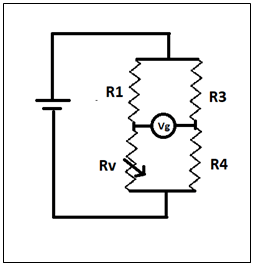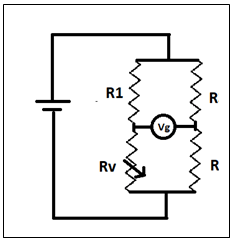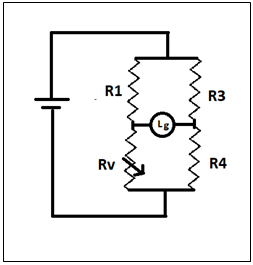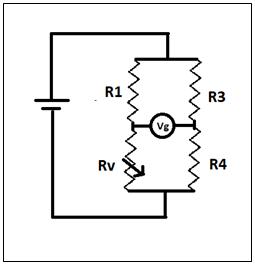This set of Mechatronics Multiple Choice Questions & Answers (MCQs) focuses on “Analog Signal Conditioning – Bridge Circuits – 1”.
1. Who invented wheatstone bridge?
a) Samuel wheatstone
b) Charles Wheatstone
c) Charles manes
d) Samuel Hunter Christie
View Answer
Explanation: Wheatstone bridge was invented by Samuel Hunter Christie. He was the one behind the concept which was further developed and popularised by Charles Wheatstone. After whome it was named as wheatstone bridge.
2. Why wheatstone bridge is generally used in DC ciruit?
a) To determine resistance
b) To determine capacitance
c) To determine inductance
d) To determine flux
View Answer
Explanation: Wheatstone bridge is generally used to determine an unknown resistance in a circuit. It creates a balanced bridge of 4 resistors in which the ratio of two resistance of specific side is equal to the ratio of the other two sides.
3. What should be the value of Rv, for the bridge to be balanced?
(Given that: R1=3 ohm, R3=6 ohm, R4=2 ohm)

a) 3 ohm
b) 2 ohm
c) 6 ohm
d) 1 ohm
View Answer
Explanation: Given:
R1=3 ohm
R3=6 ohm
R4=2 ohm
We know that for a wheat stone bridge to be balanced R1/R3 = Rv/R4,
Ra/R3=3/6=>1/2
Therefore Rv/R4=1/2
Rv/2=1/2
Rv=1ohm
4. Who invented Wien bridge?
a) Samuel Wein
b) Max Wein
c) Charles wheatstone
d) Samuel Hunter Christie
View Answer
Explanation: Wien bridge was invented by Max Wein. It was developed in 1891. A Wien bridge consists of 4 resistors and 2 capacitors. This bridge is used to determine unknown capacitance in terms of resistance and frequency.
5. In a balanced wheatstone bridge, maximum current passes through galvanometer.
a) True
b) False
View Answer
Explanation: In a balanced wheatstone bridge, no current passes through galvanometer. In a balanced wheat stone bridge there are 4 resistors in which the ratio of two resistance of specific side is equal to the ratio of the other two sides. In this condition no current flows through the galvanometer connected at two opposite vertices.
6. Wheatstone bridge can be used to calculate capacitance in AC circuits.
a) True
b) False
View Answer
Explanation: Wheatstone bridge can be used to calculate capacitance in AC circuits. Wheat stone bridges are generally used to calculate the overall impedance of the AC circuits. It can also be used to calculate inductance as well as dissipation factor in an AC circuit.
7. Wheatstone bridge with high DC input cannot be balanced.
a) True
b) False
View Answer
Explanation: Wheatstone bridge with high DC input can be balanced. Balancing of wheatstone bridge does not depend upon the DC input, it totally depends on the value of resistors that we are using in the circuit. Therefore irrespective of the input, the bridge can be balanced.
8. What is the deflection in galvanometer(Vg)?
(Given that: R1=3 ohm, R3=9 ohm, R4=6 ohm, Rv=2 ohm)

a) 90 degree deflection
b) 180 degree deflection
c) No deflection
d) 45 degree deflection
View Answer
Explanation: Given:
R1=3ohm
R3=9 ohm
R4=6 ohm
Rv=2 ohm
We know that for a wheat stone bridge to be balanced R1/R3 = Rv/R4,
Ra/R3=3/9=>1/3
Rv/R4=2/6=>1/3
So the circuit is balanced, therefore no current will flow through the galvanometer. So there will be no deflection in the galvanometer.
9. What is will happen to the light(Lg)?
(Given that: R1=2ohm, R3=8 ohm, R4=4 ohm, Rv=1 ohm)

a) Light will flicker
b) Light will glow constantly
c) Light will not glow
d) Light will turn on for 5 second and then turn off
View Answer
Explanation: Given:
R1=3 ohm
R3=9 ohm
R4=6 ohm
Rv=2 ohm
We know that for a wheat stone bridge to be balanced R1/R3 = Rv/R4,
Ra/R3=2/8=>1/4
Rv/R4=1/4
So the circuit is balanced, therefore no current will flow through the branch containing the light, therefore the light will not glow.
10. What should be the value of Rv and R4 for the bridge to be balanced?
(Given that: R1=4 ohm, R3=8 ohm,)

a) Rv = 3 ohm, R4 = 4 ohm
b) Rv = 2 ohm, R4 = 4 ohm
c) Rv = 6 ohm, R4 = 5 ohm
d) Rv = 1 ohm, R4 = 7 ohm
View Answer
Explanation: Given:
R1=4 ohm
R3=8 ohm
We know that for a wheat stone bridge to be balanced R1/R3 = Rv/R4,
R1/R3=4/8=>1/2
Therefore Rv/R4 should be 1/2
Rv/R4=1/2 or 2/4
Rv=2 ohm R4 = 4 ohm
11. Who invented Schering Bridge?
a) Samuel Schering
b) Max Schering
c) Charles Wheatstone
d) Harald Schering
View Answer
Explanation: Schering Bridge was invented by Harald Schering. It is a type of AC (Alternating Current) bridge. A balanced Schering bridge is independent of frequency change and is used for measuring insulating capacity of cables.
12. Which is a type of DC bridge?
a) Maxwell’s Bridge
b) Hay’s Bridge
c) Wheatstone Bridge
d) Schering Bridge
View Answer
Explanation: Wheatstone bridge is a type of DC (Direct Current) bridge. Maxwell’s bridge, Hay’s bridge and Schering bridge are a type AC (Alternating Current) bridge. Wheatstone bridge is generally used to determine an unknown resistance in a circuit.
13. Which is a type of DC bridge?
a) Anderson Bridge
b) Wein Bridge
c) Kelvin Bridge
d) Schering Bridge
View Answer
Explanation: Kelvin bridge is a type of DC (Direct Current) bridge. Anderson bridge, Wein bridge and Schering bridge are a type AC (Alternating Current) bridge. Kelvin bridge is generally used to determine an unknown resistance in a circuit below 1 ohm.
14. Which bridge is also called as Thompson Bridge?
a) Anderson Bridge
b) Wein Bridge
c) Schering Bridge
d) Kelvin Bridge
View Answer
Explanation: Kelvin bridge is also called as Thompson bridge. It is a type of DC (Direct current) bridge. Kelvin or Thompson bridge is generally used to determine an unknown resistance in a circuit below 1 ohm.
15. A galvanometer cannot be used for detecting and balancing AC (Alternating current) bridges.
a) True
b) False
View Answer
Explanation: A galvanometer cannot be used for detecting and balancing AC (Alternating current) bridges. It can only be used in DC (Direct current) circuits and bridges. If a galvanometer is placed in an AC circuit then its needle will continuously deflect back and forth and will never be stable.
Sanfoundry Global Education & Learning Series – Mechatronics.
To practice all areas of Mechatronics, here is complete set of 1000+ Multiple Choice Questions and Answers.
If you find a mistake in question / option / answer, kindly take a screenshot and email to [email protected]